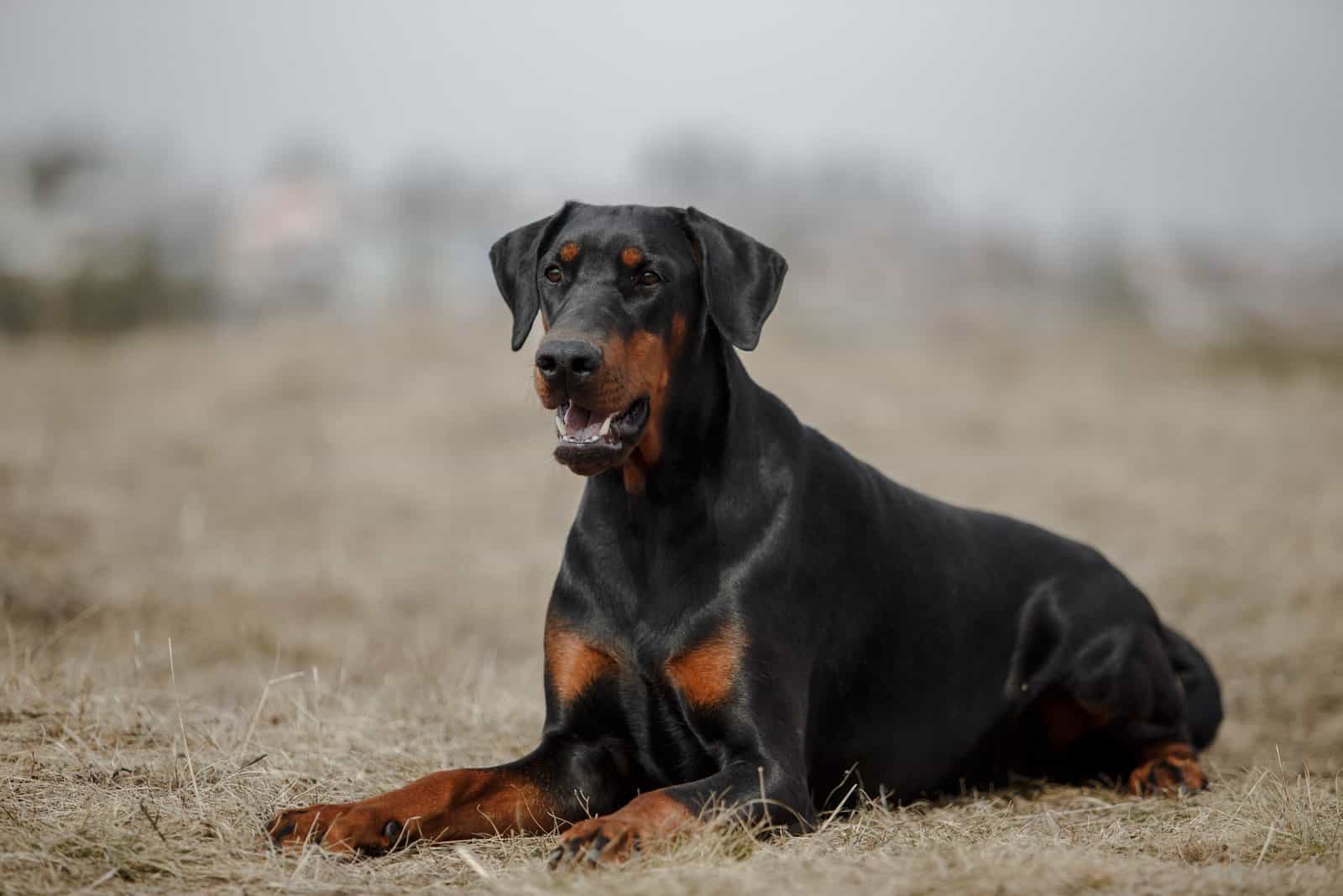Dobermans are one of those dog breeds with completely wrong and bad publicity. Many people believe Dobermans are dangerous dogs. But, the truth couldn’t be further from this claim.
Dobermans are as sweet as any other dog breed. They were bred to be loyal protectors and dear sidekicks. Their friendly personality is what makes Doberman dogs a delight to own. Many families opt for this dog breed as their four-legged family member.
Now, you see why Dobermans are in such high demand. But, before you get one of these gentle giants, you will need to learn a thing or two about this dog breed. How much do they weigh? When will they stop growing? How large is an average Dobie?
An average Doberman weighs 70 to 90 pounds (males), and 55 to 85 pounds (females). But, not every Dobie falls into the same category on the Doberman growth chart.
Dogs are not all alike. Some are more active, and thus, slimmer, while others are couch potatoes with a couple of extra pounds.
If you’re a new Doberman owner, you can use the Doberman growth chart as sort of a guide to tell you what to expect on your Doberman puppy’s way to adulthood.
Doberman Puppy Growth Chart For Males
[table id=348 /]
Doberman Puppy Growth Chart For Females
[table id=349 /]
A Word On The Doberman Breed
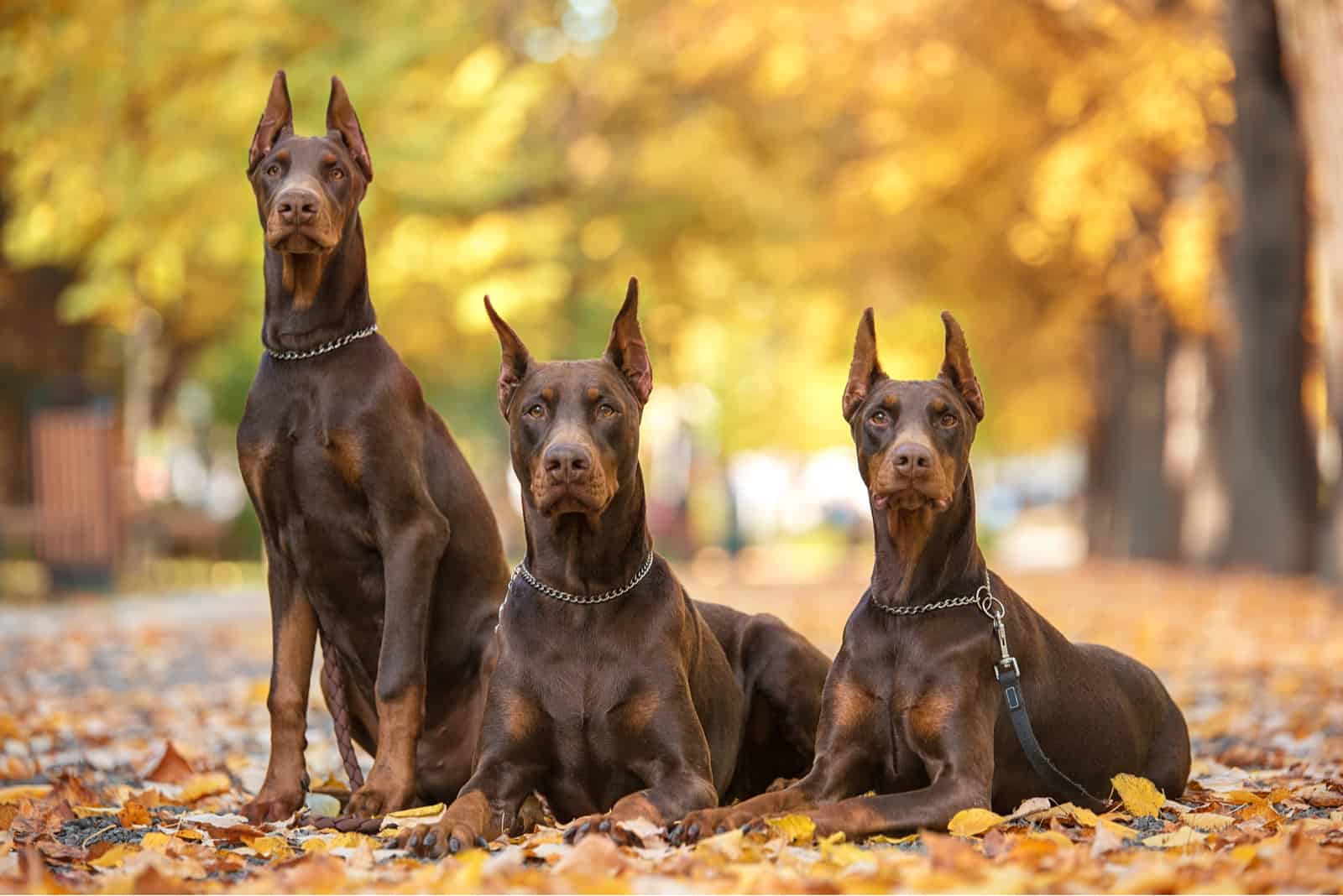
They come from the late 19th century, and they decided to stick around and make everyone feel intimidated by their looks. Yup, they’re Dobermans!
Just kidding! A Doberman’s purpose is not to scare people. He was bred for protection! But, today’s Dobermans are more than just protectors. They’re dear buddies, loyal to the bone, and ready to sacrifice everything for your sake. Once you have a Doberman friend, you have a friend for life.
I completely understand why Dobies are used by police and military services, besides the GSD. They’re disciplined, easy to train, and respect their pack leaders. A Doberman is the real MVP! An intelligent pup that will show you that brains and brawn go together!
Appearance Traits: What Does A Doberman Look Like?
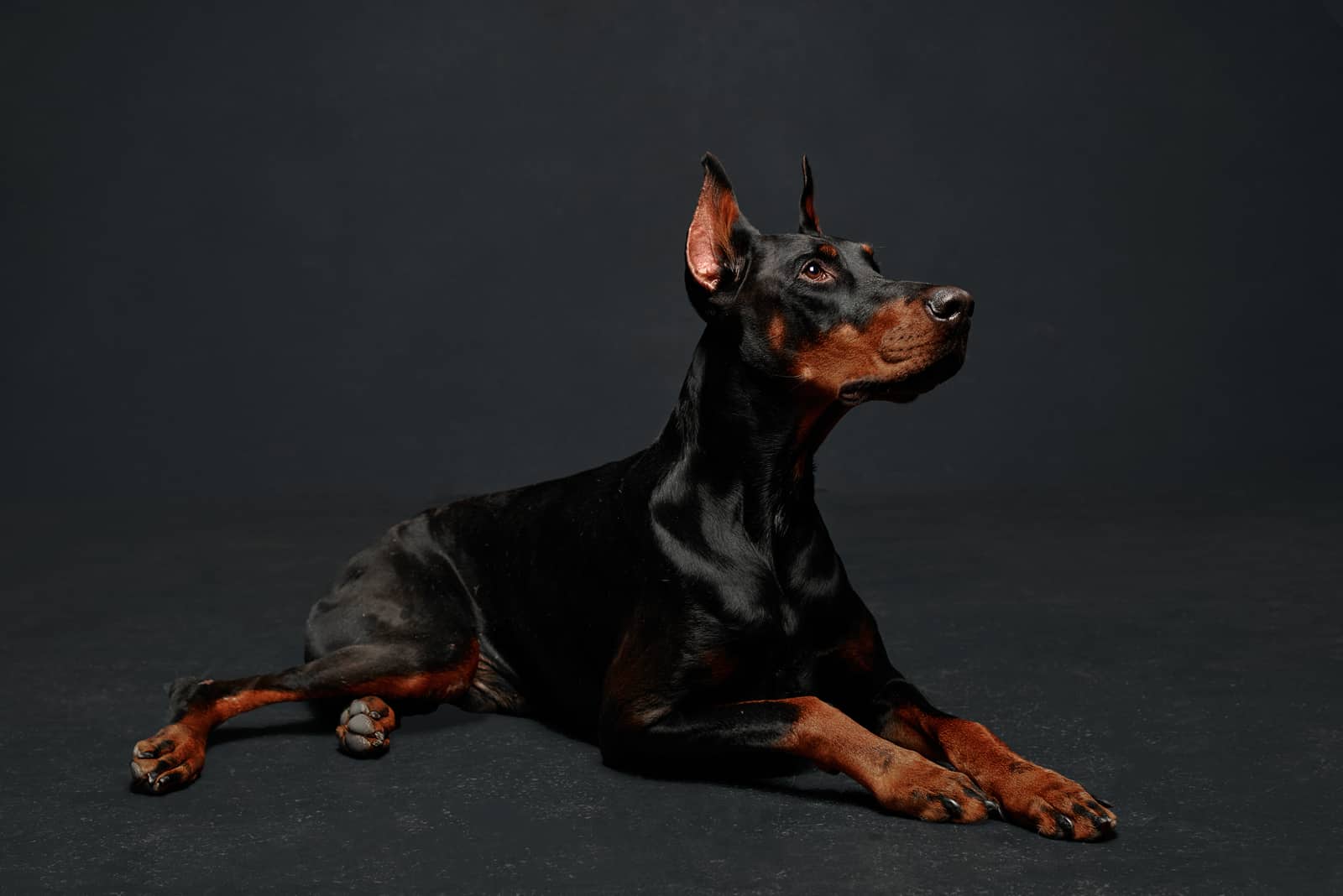
Standing tall at 28 inches at the withers, Dobermans are fairly large dogs that will scare away intruders.
No wonder people are afraid of them!
When I was a kid, a family down the street had a Doberman. She was a sweet girl once I got to know her and once she got to know me. But, before that, tragedy! I was so afraid of her that I used to cross the street away from their house. Sheila was a robust girl. Her owner, an ex police officer, brought her home from the service. The first time I saw that dog, I thought: That’s a demon dog. Look at its ears!
I didn’t know they were the signature Dobie pointy ears. I bet they can hear for miles with those radars! Nowadays, I see many uncropped ears with Dobermans, and I’m glad this cruel practice is coming to an end. I love these Dobies as they resemble large Dachshunds.
Sheila was covered in muscles, like every other Doberman dog. She loved working out, and used to run with her owner every morning.
Once I got to know her, I saw that she could be friendly, too!
You see, Dobermans are very careful with new people. They don’t let in just anyone. If you get into their inner circle, you’re safe for life! This is the best dog if you want a guardian and a companion.
Dobermans usually come in a variety of shades of black, rusty, red, fawn, or blue. They have a super silky coat, and are low-shedding, so you don’t need to brush that often (hooray!). I remember Sheila was a black and tan Dobie; a pretty common Doberman color I’d say. I used to love petting her smooth coat as she gazed into my eyes.
Man, I really miss that dog. If I knew what I know today, I wouldn’t have been scared of her. I would have ran down the street and played with her as much as I could.
Doberman Puppy: Puppy Years (Months) 101
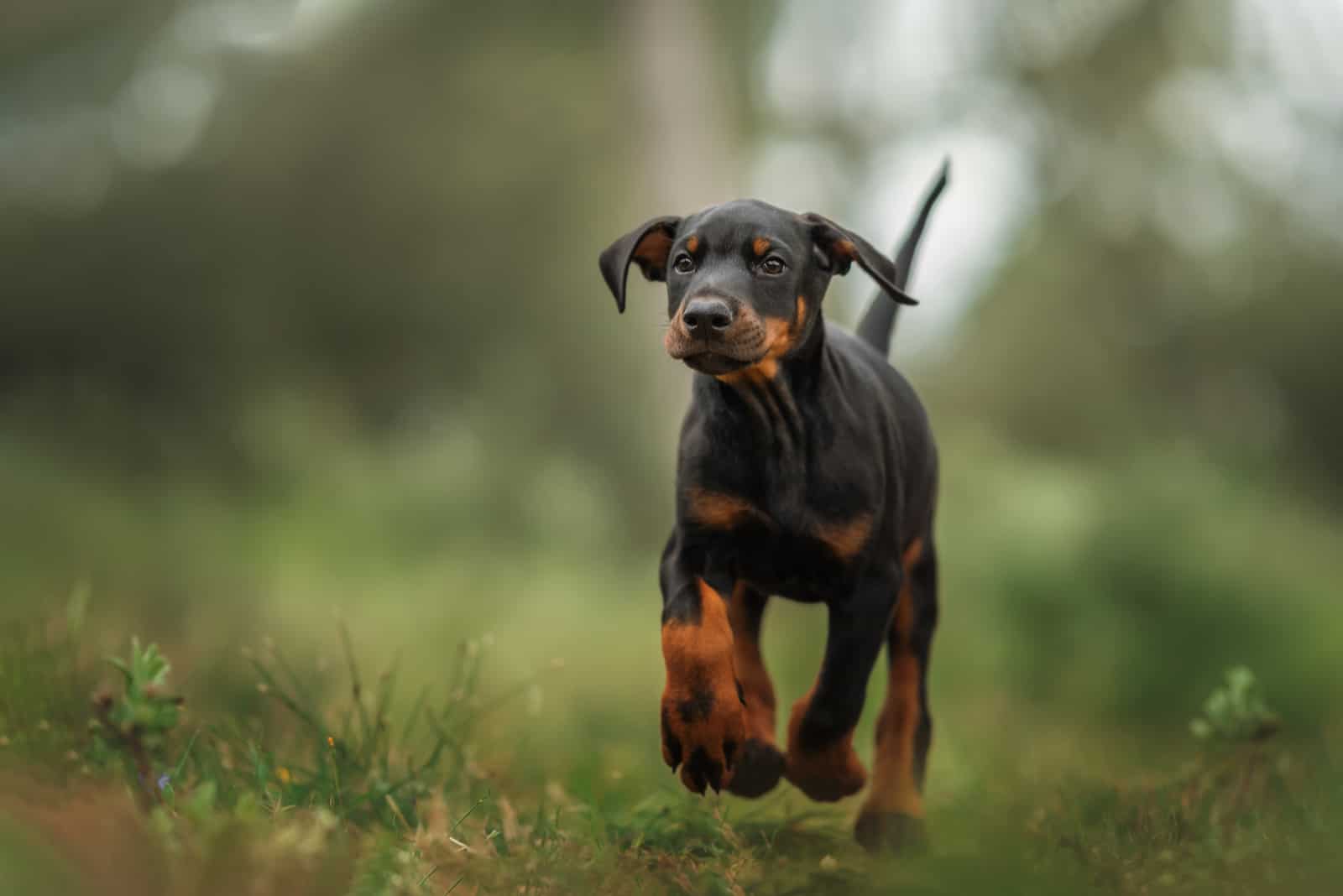
Even though they’re quite large dogs, newborn Doberman puppies are quite tiny. They weigh between 10 and 20 ounces. Their eyes and ears are shut at birth, and they nurse every hour or two.
The puppies will experience rapid growth within the first two weeks. After two to five days, many dog owners let the vet dock the Doberman puppy’s thin tail and have its two dewclaws removed.
Two weeks after the puppies are born, you can see their eyes starting to open and gaze into their world with amazement. The puppies at this stage are bigger than a human’s hand, and will weigh more than a couple of pounds. Still, they will be quite wobbly and unsure on their feet.
At this stage, Doberman puppies begin to move more. Their sight is much better now! Curiosity kicks in, and puppies begin to explore. Still, they will spend lots of their time sleeping.
By the time the puppies turn four months of age, they will know how to walk properly and will show off their personalities in the litter. They’re still nursing puppies, pretty much depending on their mom, but it’s time for some changes. It’s time to let them in on a secret: they can start munching solid foods!
At five months of age, weaning is in full progress. The mommy Doberman will only nurse once or twice a day. The puppies are now eating soft solids and drinking water. The puppies should be fully weaned by now. Their weight will also increase and show eight pounds on the scale. They’re now active dogs that need lots of attention and socialization.
What’s characteristic about this dog breed is that they have their ears cropped at seven to nine weeks. The ear crop gives them the recognizable Doberman look.
When they turn six months, Doberman puppies begin to have two meals a day, followed by some snacks. However, don’t hand out snacks all the time as puppies tend to put on extra weight. If a dog carries a healthy weight, then you should easily feel its ribs. If you don’t, then you should cut down on the treats.
At this stage, puppies get their first permanent teeth. Also, the ears should be sitting up straight.
Some sources claim males and females should be spayed or neutered at this age. Females usually get their first heat cycle early. Expect changes in this field at the 6th-month milestone. However, some dames start the cycle later, at nine months of age. More experienced experts claim these procedures should wait until the females go through their first cycle, and the males turn 12 months of age.
Most females reach their adult weight and height after going through their first heat cycle. This happens around the 7th month of age. Females should weigh between 50 and 65 pounds. Males are naturally bigger, with 60 to 80 pounds, and full adult height around 18 months.
Male Dobermans, as the breeders say, put on 10 pounds each month. For example, each month equals 10 pounds times the month. A puppy of four months old should have 40 pounds, at 8 months, it’s 80 pounds, etc. However, this fast weight gain will stop after the 8th-month milestone.
Doberman puppies are still on their way to adulthood. This is the ideal time to have them fixed and ready to spend a long, fulfilling life with their owner.
Welcome To Adulthood!
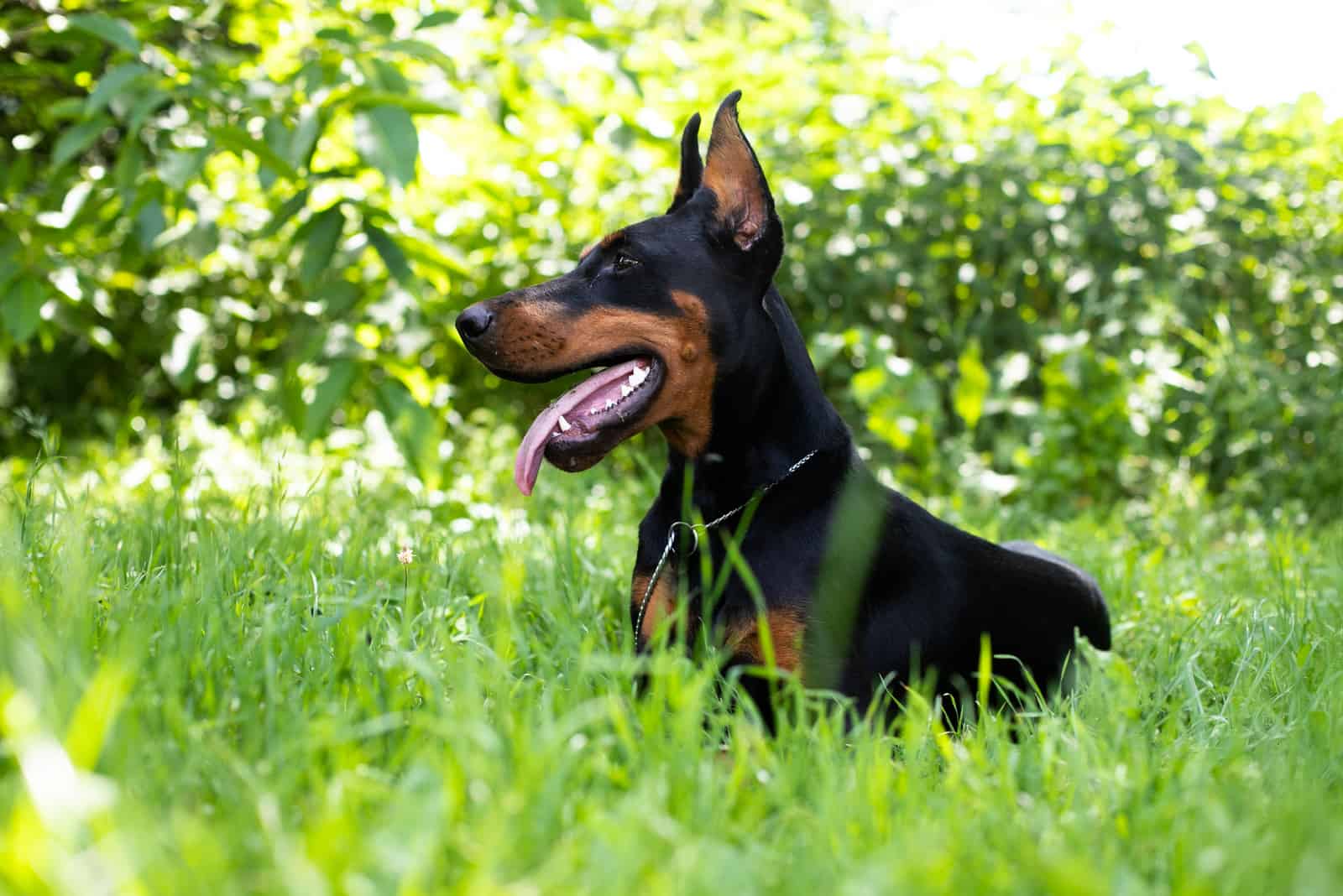
When the Doberman puppy turns 12 months of age, he is considered an adult. Still, they’re not fully matured yet mental-wise.
This is the time when the dog forms a strong bond with its owner and becomes a loyal sidekick. As Dobermans are excellent protectors, you will experience their guarding side… of course, if you give attention and care in return.
Over the next year, your male Dobie will still grow, but the changes won’t be that noticeable. Actually, the growth is more height-oriented, and it will stop around their 3rd birthday. Females experience their final growth spurt between their 2nd and 3rd birthday.
How Big Do Dobermans Get?
We all know Dobermans are large dogs, but we can’t help but wonder: how big will a Doberman puppy be once he grows up? Do puppy weight and adult weight differ that much?
Take a look at a Doberman growth chart first. You should be able to compare your dog’s measurements with the stars in the growth curve.
Also, look at the dog’s parents. You will get a good picture by looking at both parents and asking questions about their weight.
Lastly, the old paw never lies. If the paws are large, you will have a large dog… as simple as that!
If you’re still not sure about your dog’s future weight, it’s time to do some DNA tests!
When Do Dobermans Stop Growing?
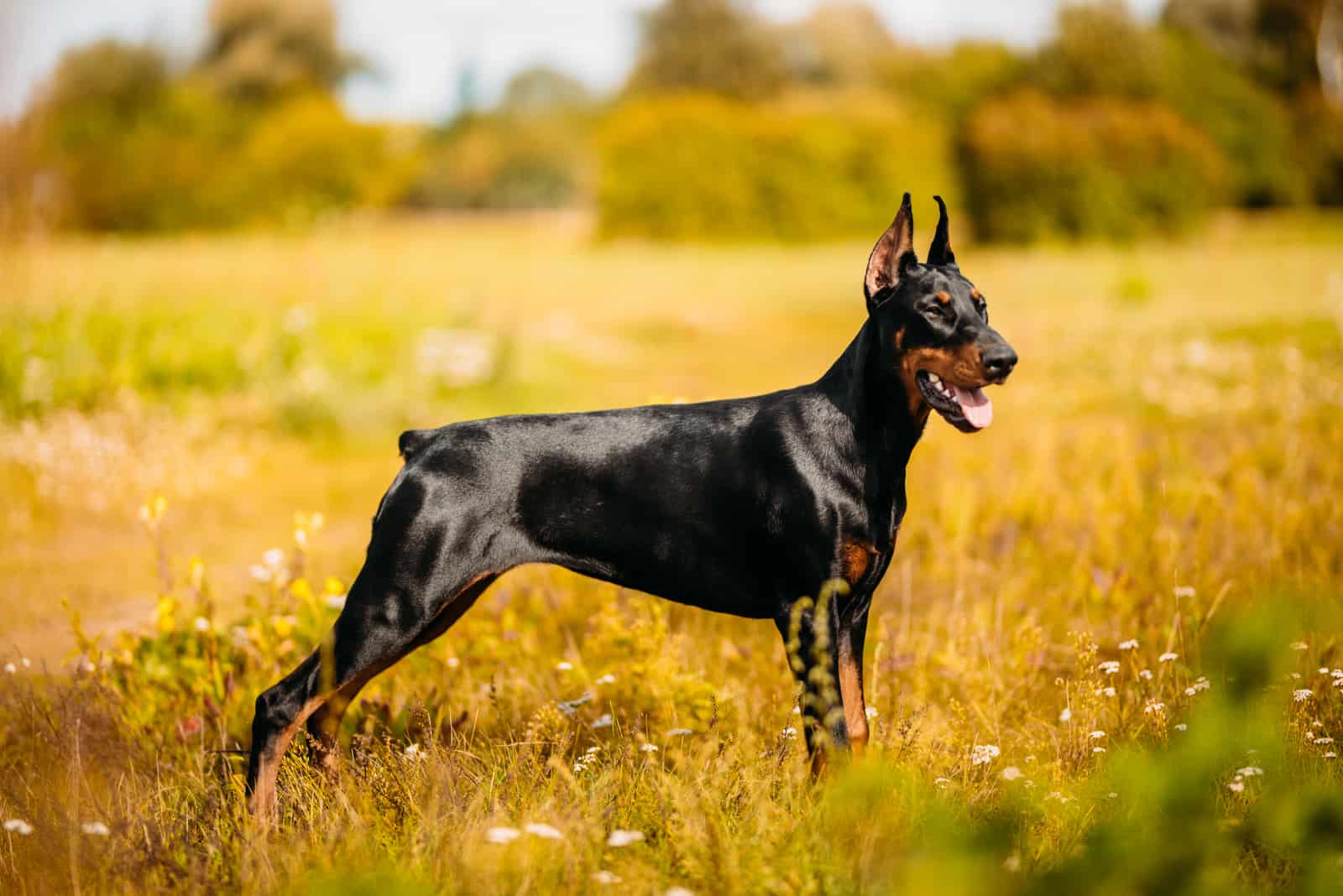
Generally speaking, the Doberman Pinscher dog will achieve its full size around its first birthday. However, this is only a general rule. On average, both females and males stop growing and putting on weight between seven and 12 months of age.
At this stage, their body becomes thicker, but they still grow slightly in height.
Some extreme cases have noted that Dobermans may even grow a little bit even after they turn two years of age.
European Doberman: How Different Is He?
The European Dobermann or the Dobermann with two n’s is more muscular and bulkier than its American cousin. The bone structure of these dogs is also thicker. The European Doberman has a blocked head with a snout, and a broad chest, meaning they will weigh more.
Our growth charts as well as puppy growth charts for the American Doberman can be applied to the European version, too.
The European Dobermann will be nearly 100 pounds.
The Federation Cynologique Internationale (FCI) defines these measurements as the breed standard weights for the European Dobermann:
Males: 88 to 99 pounds
Females: 71 to 77 pounds
The European Doberman also has variations in size within the breed, just like the American Doberman. However, the FCI has much stricter breed requirements than the American Kennel Club (AKC).
If you really want a European Dobermann, I recommend you take a look at this compelling list of best European Dobermann breeders.
Is A Puppy’s Growth Affected By Spaying Or Neutering Procedures?

Many future dog owners wonder if spaying or neutering affects a Doberman’s weight. Do Dobermans really keep on growing after these important procedures and changes in their body?
The good news is, spaying or neutering doesn’t affect the dog’s weight. Dogs still keep on growing after they’re fixed. However, there are some other factors that should be considered prior to these procedures.
Large dog breeds like the Dobie should be spayed or neutered after they have finished growing. This is usually around after the first year of age. Females should be fixed after their first heat cycle.
Scientists have proven that large dogs will have some difficulties with growing, especially with their growth plates if they’re submitted to these procedures before they’re all grown up. This may even result in severe issues with mobility, especially in their senior years.
Have You Ever Heard Of The Body Condition Score?
Every human being should be familiar with the BMI or the Body Mass Index. Every dog owner should know what BCS is. The BCS or Body Condition Score, just like the BMI, is used to calculate healthy weight. However, it’s not that straightforward in dogs as it is in humans. Dogs vary in size a lot. That’s why we’ll discuss only the BCS of the Doberman.
Generally speaking, the BCS scale goes from 1 to 9, with 1 being the indicator for underweight dogs without muscle mass or fat, and 9 being the indicator for obesity, when you can’t feel the dog’s ribs under all that fat.
Ideally speaking, every dog should be a 5 on the BCS scale. This means the dog is healthy, following standard weight guidelines. You are able to see its ribs. The waist is also visible when you look at the dog from above.
How To Properly Weigh Your Doberman
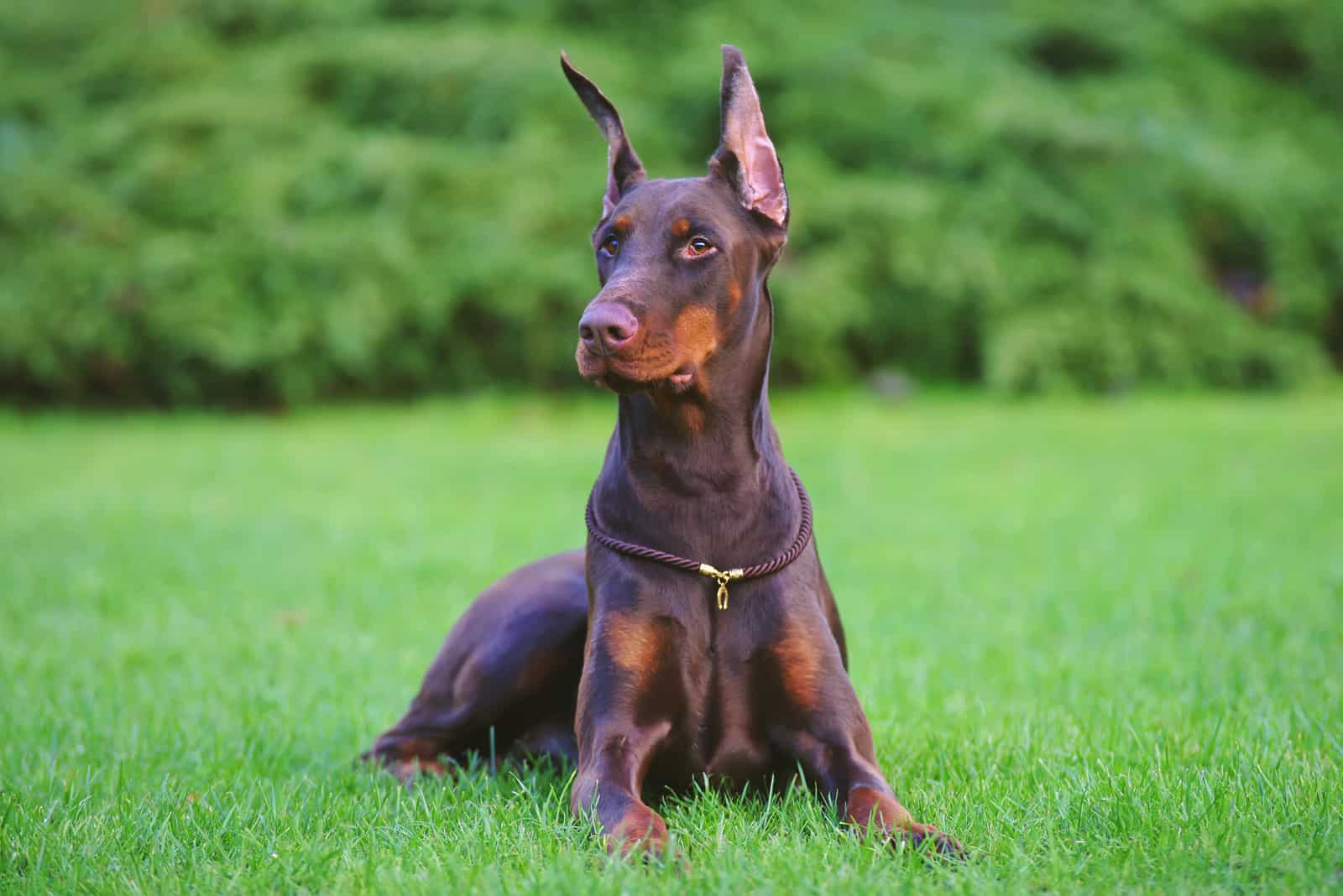
You know how you step on the scale almost every morning? Well, you should weigh your Doberman, too, but not that often. But, how do you put a four-legged friend on a scale? How do you properly weigh a Doberman dog?
Measuring Doberman puppies is fairly simple. You can use a basic home scale for weighing puppies. First, you step on the scale and mark down your weight. Then, grab your dog and weigh the two of you together. The difference between the two measures is your dog’s weight.
But, weighing an adult Doberman can be tricky. You can buy a dog scale, but they’re pretty expensive, and you won’t need them that often. Luckily, every visit to your vet can be an opportunity to weigh your dog.
Adult Dobermans should be measured every six months, while puppies require weekly measuring to make sure they’re at the right growth rate.
Helping An Overweight/ Underweight Doberman
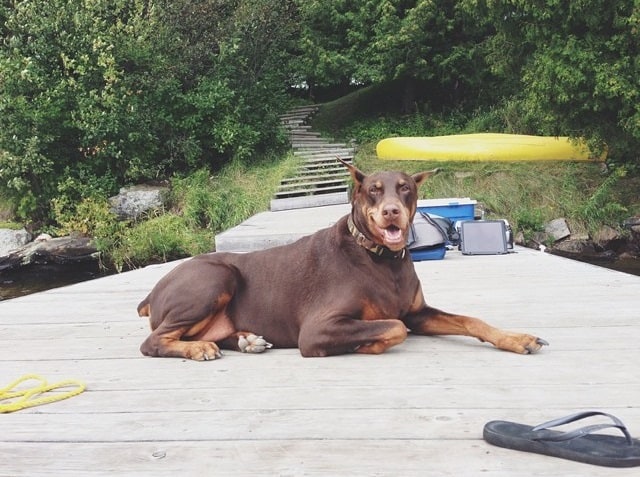
Photo from: @lalalindzie
Determining whether the dog is underweight or overweight is performed by a visual inspection. You can’t completely rely on weight charts. The numbers vary because not all dogs of the same breed are alike.
Some dogs have large frames, while others are small. Some Dobermans are very active, meaning they carry more muscles. That’s why we have Dobies that weigh more than others.
If you have an underweight Doberman (let’s say he’s 10% below the recommended weight) that’s quite serious. Underweight dogs easily develop health problems, seem to have a wobbly emotional status, and have poor life quality.
Underweight dogs have visible ribs and bones sticking out, making them look severely ill. When you look at an underweight dog from the side, you’ll clearly see these bones protruding.
It looks like there’s no fat, and the only thing between the dog’s skin and bones is thin air. Significant muscle mass loss is a clear indicator that your dog is becoming underweight, so pay attention!
Overweight dogs carry a lot of health issues. They’re usually prone to problems with their bones, joints, and, sadly, life-threatening diseases.
Overweight dogs get injured easily when performing strenuous tasks. Besides the obvious signs of obesity, the dog will act lethargic and depressive.
Such dogs have rib cages covered in fats. The waist isn’t visible, their tummy is hanging down, and the abdominal tuck is minimal. You can say they look poofy!
But, how do you help these dogs? Does the Dobie stay overweight or underweight forever?
The change happens with changing the dog’s food, limiting or offering more treats, and performing exercises with different intensity.
Underweight dogs need good fats, proteins, carbs, fibers… things that will help them put on weight fast, but in a healthy way. Also, feel free to hand out treats to speed up the process.
Overweight dogs need the opposite. Many dog food brands even carry special, light dog kibble for such dogs.I recommend them as they’re based on light proteins from poultry meat.
It’s up to you to buy the best food possible for your Doberman. Of course, keep your budget in mind.
Luckily, there are lots of good deals online. And, I’ve seen some pretty amazing small brands selling top-quality food. Don’t go to your local pet store. Dig a little and find hidden treasures!
What Are The Health Problems Affecting The Doberman’s Growth?
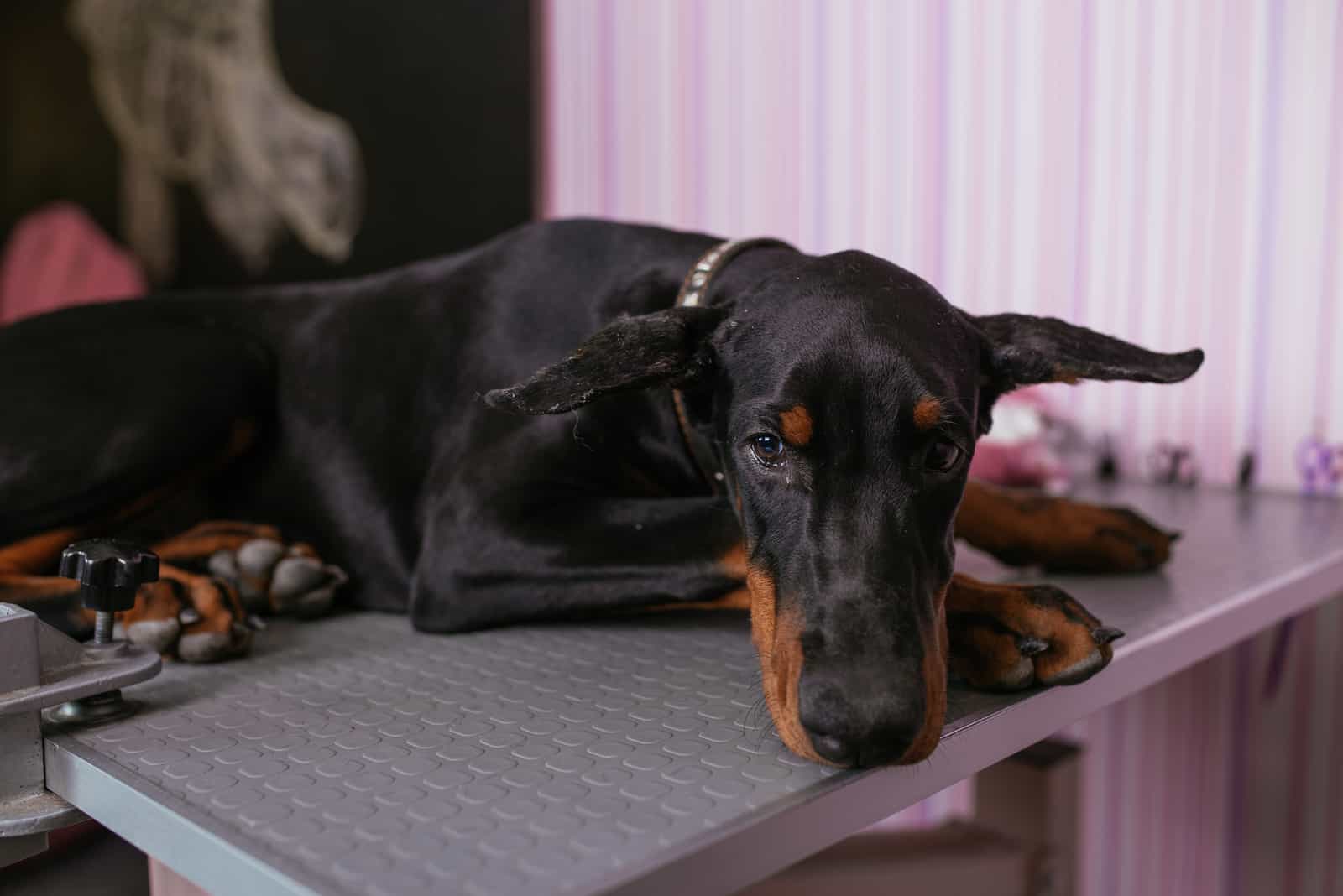
Dobermans should go to regular vet exams to prevent health issues. This dog breed can suffer from many health conditions, including:
• dilated cardiomyopathy (a disease of the heart muscle)
• hypothyroidism
• Wobbler syndrome
• color dilute alopecia
• Dancing Doberman Syndrome
Von Willebrand’s disease is a bleeding disorder. Humans have hemophilia, and Dobermans have VWD.
If your adult dog loses hair and becomes obese, it may be a sign of hypothyroidism.
A stiff neck that tends to be sore is a clear sign of Wobbler syndrome.
Color dilute alopecia occurs only with Dobermans that have a fawn or a blue coat color. Rarely does any other color get it. But, you can notice CDA if a dog has a patchy coat in poor condition.
The Dancing Doberman Syndrome sounds funny, but it actually isn’t. It’s a condition when the dog’s legs are being restless, flexing all the time as the dog stands. It affects all four legs.
As you can see, a word on each most common disease is enough to conclude that there are severe health conditions that affect the growth of this dog breed. I’d hate to see a Doberman having growing issues because of thyroid gland problems or VWD.
Take care of your Dobie’s health as you take care of yours!
Which Factors Are Responsible For Changes In The Growth Curve?
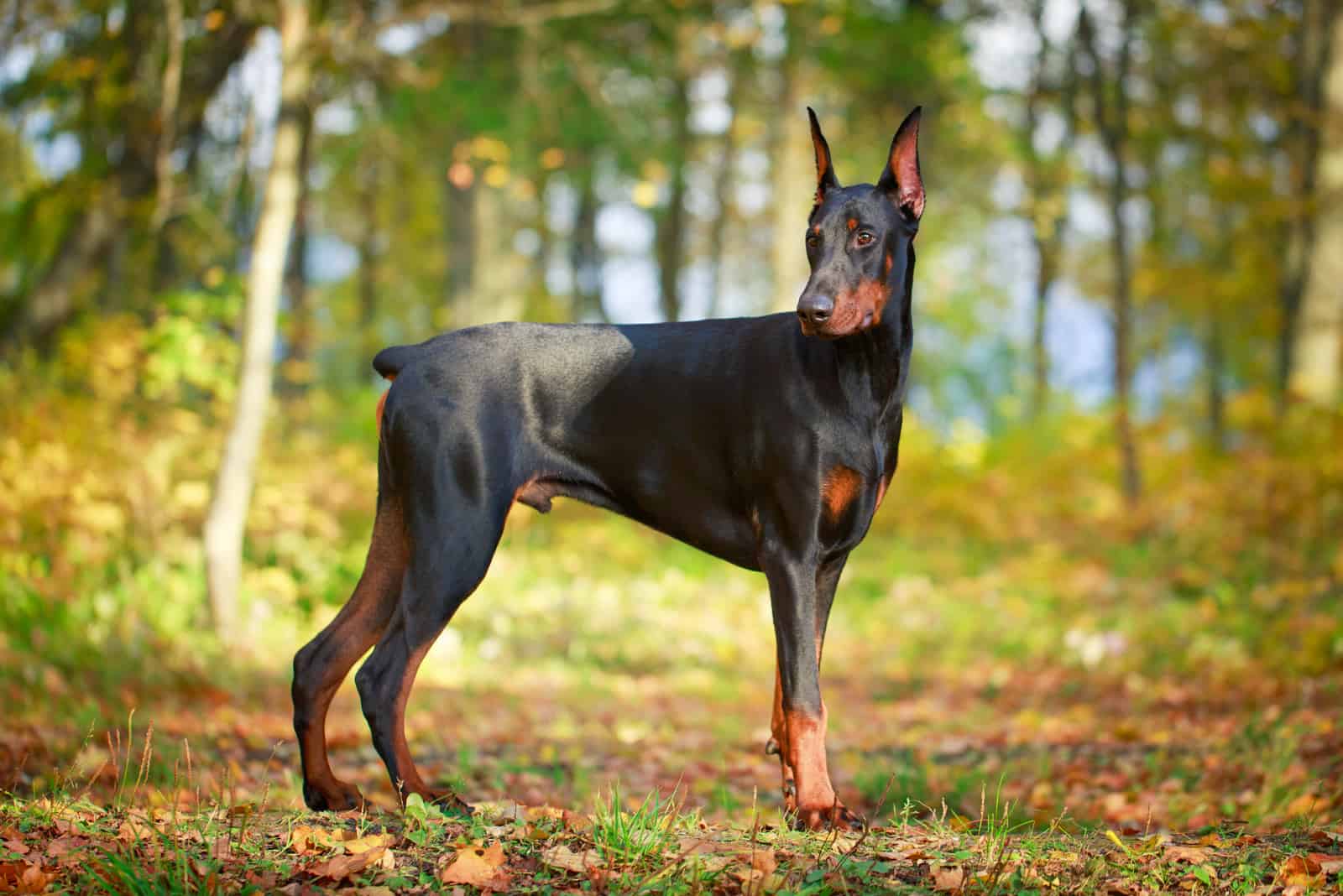
Even within this breed, there are differences between some Dobermans. Some are bigger, while others are smaller.
Genetics plays a major role in the dog’s adult weight. There were even cases of Dobermans weighing up to 120 pounds! I wouldn’t like to imagine what that amount of weight did to the poor pup’s bones and joints.
Dobermans are sleek dogs that stay slim during their entire lifetime. Still, you need to provide high-quality dog food that will satisfy their needs, and will not put on additional weight.
Adult Dobermans need lots of exercise daily, preferably two hours or so. Dogs with a sedentary lifestyle will eventually put on additional weight, and that’s not healthy for a Doberman.
How Long Are Doberman Females Pregnant?
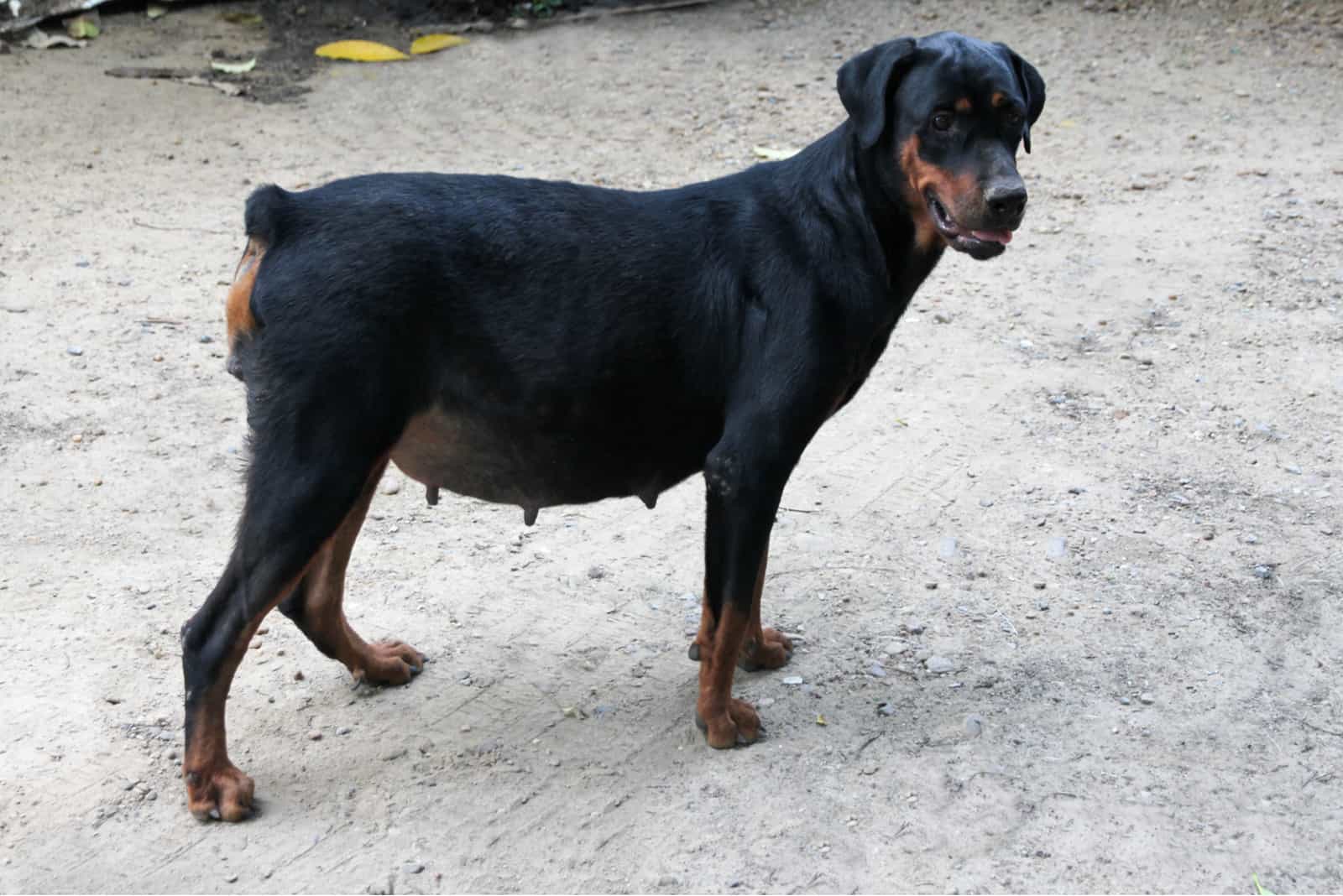
The average gestation period with dogs is 57 to 63 days. Some days over or under this milestone are completely fine since we don’t know when the pregnancy took place. As a good dog owner, you should help mommy Doberman by introducing her to a new diet that is specially designed for future moms. This will give her strength to raise happy little Dobies!
How Big Are Their Litters?
Doberman litters are generally very healthy. I haven’t experienced any problem with them in my practice.
On average, a female Doberman will give birth to up to eight puppies. Usually, the average is six healthy pups. This is a good number, and she will have plenty of time to show each Dobie puppy that it’s loved.
FAQs
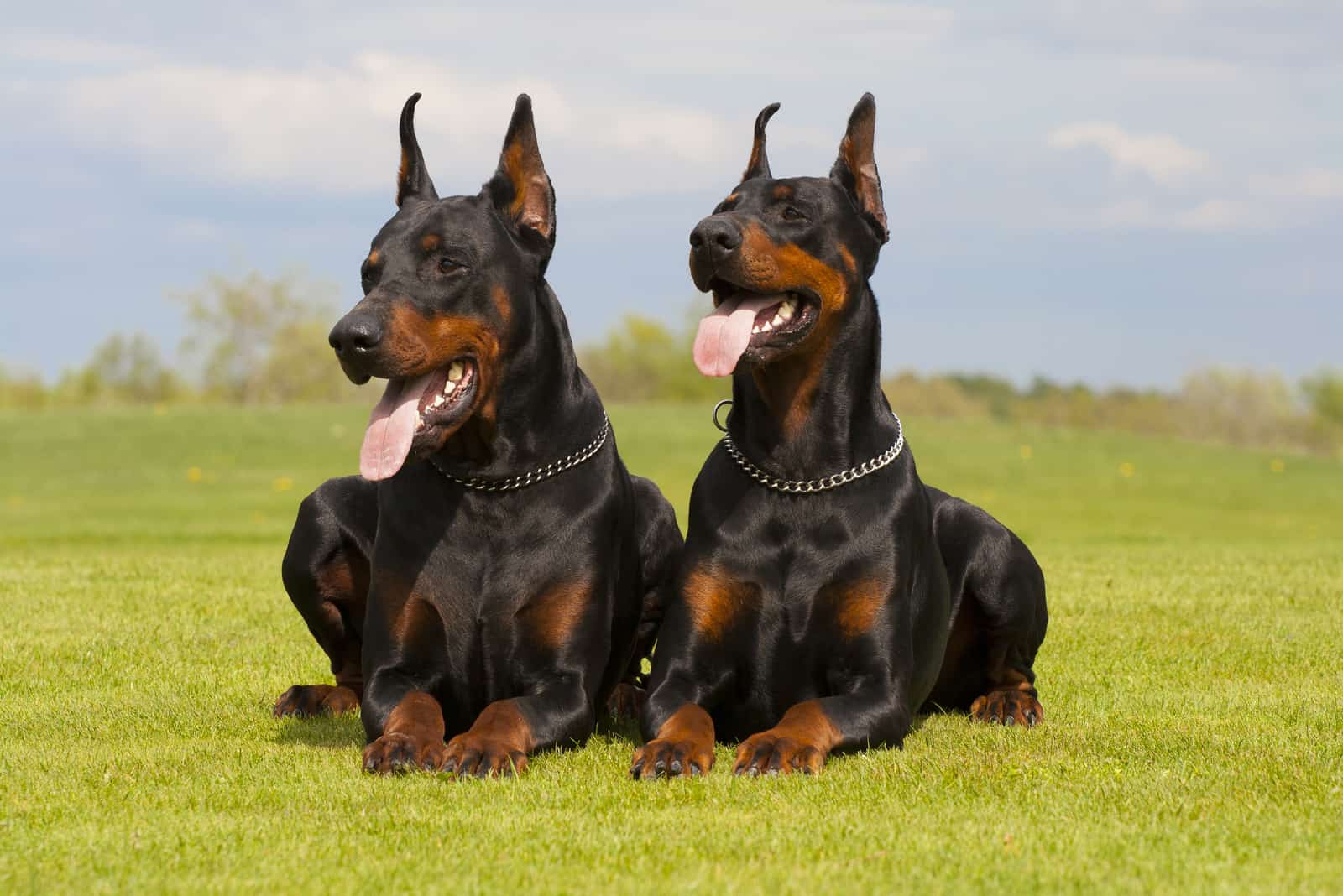 1. What’s a Doberman’s average lifespan?
1. What’s a Doberman’s average lifespan?
Like many other large dog breeds (i.e., the Great Dane), Dobermans don’t live that long. Large breeds grow faster, and thus, have a short lifespan.
The average Doberman lifespan is 10 to 13 years, but it depends on many factors, including genetic issues, proper care, and health conditions. If you provide a nice life for your dog, your old Doberman will spend many years with you.
2. Will a Doberman puppy cost me a lot?
The average price of a Doberman Pinscher puppy varies from one breeder to another. A reputable breeder will sell his puppies for $1,500 to $2,500. The purchase price depends on whether you want a pet-quality Doberman or a show dog.
But, this is only the beginning. Add to the bill a bag of good dog food for around $85, treats for approximately $20, and food bowls, leashes, and collars for $60.
Of course, you’ll need a bed, and since this is a large breed that is prone to bone problems, you’ll need a good one. Such beds usually go for $200+! Check Amazon for references.
And, where are vet visits and vaccinations? How about flea deworming treatments?
Owning a Doberman costs a lot.
3. How Big Is A Dobie’s Neck?
A dog’s neck size is important to know because we want our Fidos and Fionas to wear a collar. The collar keeps the dog’s ID tags safe, and helps a lot if the dog gets lost. If the collar is too large, it will slip off. If it’s too small, it may choke the dog and create bald spots on its coat.
Simply measure your Dobie’s neck by using a tape measure and take its circumference. Measure around the area where your dog usually wears the collar, as well as above the shoulders, and compare that to the dog collar size chart.
The average Doberman neck size is 16 to 18 inches in diameter. However, this size varies and depends on the dog’s build.
Don’t ever allow yourself to feel stressed out because your growing puppy doesn’t fit within measurements on our Doberman growth charts. The charts are there to give you a general idea of how a puppy will look once he becomes an adult.
It’s absolutely normal for a Doberman to be chunkier and slimmer. As you now know, many factors play a vital role in deciding how big a Doberman will be. You can’t expect a chubby puppy from slim parents.
This is only possible because of other factors like an inappropriate diet or insufficient exercises.
Let the puppies be… puppies! Let them be happy, cheerful, and have them nibble on delicious, high-quality puppy food while they spend their days playing with their friends. They don’t stay puppies forever, and truth be told, even though we love our adult Dobies, puppy Dobies are simply… the cutest!
Conclusion
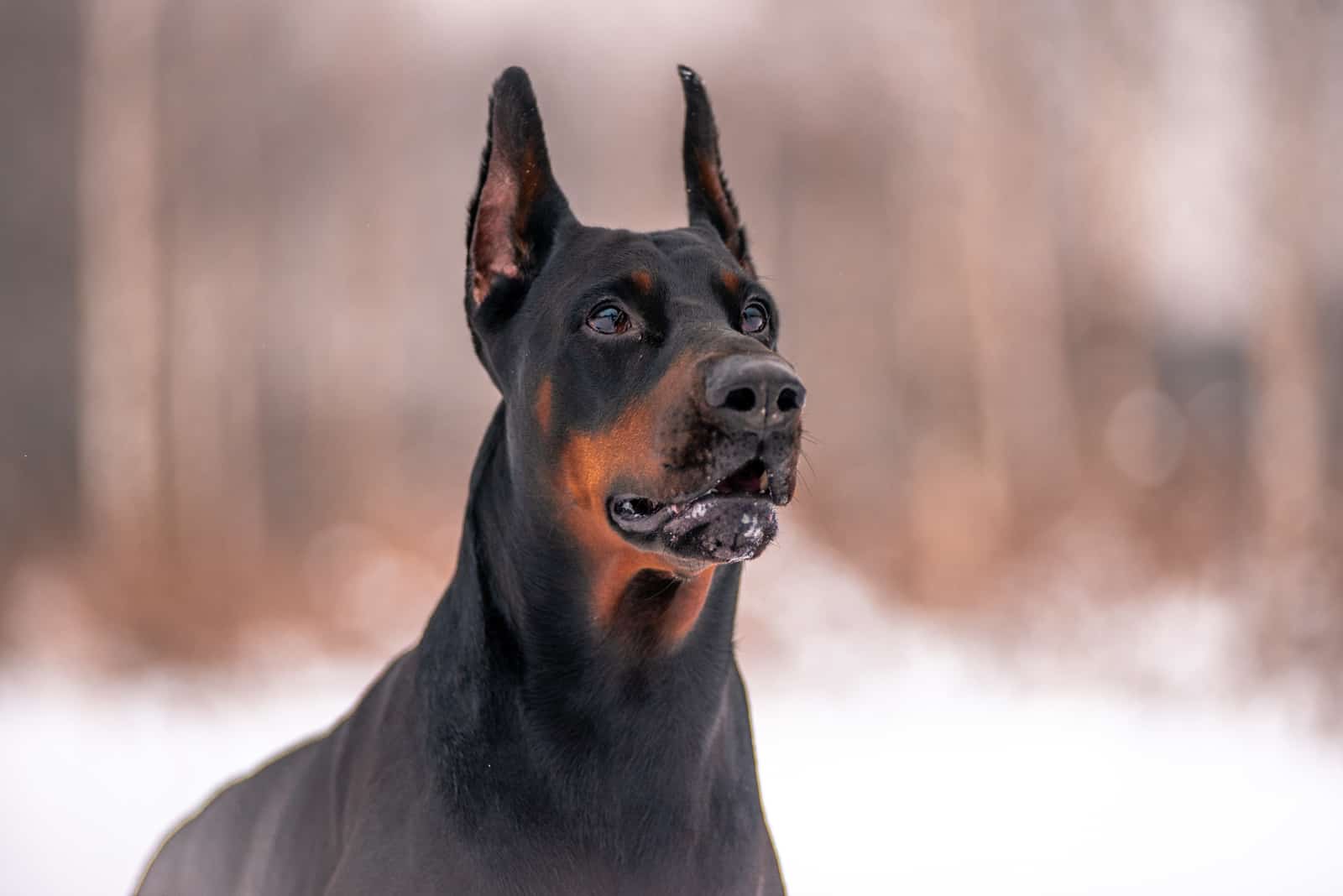
The Doberman growth chart is something quite helpful for all dog owners, especially first-time pawrents.
As you can already figure out, Dobermans are big dogs that grow until they’re two years old. They need plenty of high-quality food, an active lifestyle, and proper care to keep them on the right growth curve.
While size charts can help us determine how big our Dobermans will be, we shouldn’t follow them blindly. Not every Doberman is the same. As you can tell, we have two Doberman types within the same breed.
There’s the American Doberman and the European Dobermann. The Euro Dobie is slightly bigger than its cousin over the Atlantic.
But, both American and European Dobermans can have weight issues if not treated right. So, try to follow that Doberman growth chart. It will lead you to healthy dogs with BCS grade 5, ready to lead a long life and make you happy.
Read Next: Dogue De Bordeaux Growth Chart: How Big Are French Mastiffs?
